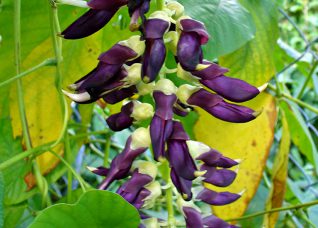
MinerAlert

MinerAlert
Mucuna pruriens
Fabaceae
Cowhage, cowitch, Bengal bean, buffalo bean, kaw ai, kratzbohnen, mucuna, nescafé, sea beans, true sea-bean, aatmaguptaa, konchh, poonaikkaali.

Pica-pica, chiporro, guisante negro, chhican, ojo de venado (Quattrocchi, 2012; Rehm, 1994).
This annual climbing shrub is native to Asia and grows in India, Pakistan, Bangladesh, among many other countries. It is now cultivated in Australia (Khare, 2016).
Principally the seed, along with the root, leaves, and pods.
The seed and seed pods are taken internally to treat various ailments (Quattrocchi, 2012, Ghani, 2003).
Velvet bean is a tropical legume that is traditionally used in Asia for controlling blood pressure (Chaudhary et al.,2015). In ancient Indian medicine, the plant has been used for a plethora of diseases and ailments, including the following: It has been used for the management of male infertility, nervous disorders, and as an aphrodisiac. The seeds have medicinal properties and have been used in the major traditional medical systems of India (Ayurveda, Siddha, and Unani-Tibb) for many centuries. The seeds are rich in the compound known as L-DOPA, which is found principally in the seeds, but also in the pods, leaves, and roots. The plant’s leaf extracts and seeds show promise for the treatment of Parkinson’s disease, male infertility, and nervous disorders, mainly due to their antioxidant (free radical scavenging) effects. Parts of the plant may also serve as aphrodisiacs. (Khare, 2016, 2007; Lampariello et al., 2012).
The pods have anthelminthic action (to eliminate intestinal worms). A tea made from the root is sweetened with honey is used to treat cholera. A leaf paste is applied topically for skin ulcers (Ghani, 2003).
The seeds can lower blood glucose levels, the hairs on the pods are taken as a syrup to kill intestinal worms, the crushed seeds combined with molasses are ingested to kill gastrointestinal parasites, a decoction of the plant is drunk to treat fever and dysentery, the roasted seeds are eaten as an aphrodisiac, and a seed decoction is taken as a tea to regularize menstrual cycles. The root and seeds have a tonic action. The roots have a stimulant, purgative, diuretic, and astringent action. A root decoction is drunk to relieve kidney ailments. The root, tied to the arm of a male partner, is said to prolong sexual intercourse (Quattrocchi, 2012; Khare, 2007).
Studies by Herrera-Chalé et al., (2016 a, b) suggested that the Velvet bean’s bioactive peptides can lower cholesterol levels and also have a blood-thinning (anticoagulant) effect. Additionally, the plant’s antioxidant bioactive compounds may also lower blood pressure. For these reason, the authors suggested that the plant might have a beneficial use as a nutraceutical supplement.
A study evaluated the effects on laboratory animals (rabbits) of an herbal combination that included Velvet bean (Mucuna pruriens). The results of the study showed that there was no mortality or any evidence of systemic toxicity, following a 2-month administration of the herbal combination (Ahmed et al., 2015).
A study employing Velvet bean standardized seed extracts concluded that the seed is a potential ACE (angiotensin-converting enzyme) inhibitor that needs to be further studied as a potentially effective option for lowering blood pressure (Chaudhary et al., 2015).
Kumar et al., (2016) studied the antiproliferative actions of an isoquinoline alkaloid isolated from the seeds of the velvet bean in hepatic carcinoma cells. The authors concluded that some of the bioactive ingredients (alkaloids) in Velvet bean were active against liver cancer cells and could be useful for a future treatment of liver cancer.
Before you decide to take any medicinal herb or herbal supplement, be sure to consult with a health care professional first. Avoid self-medication and self-diagnosis: Always be on the safe side!
Ahmed S, Khan RA, Feroz Z. Assessment of sub-chronic, hematological and histopathological toxicities of a herbal combination. Pak J Pharm Sci. 2015; 28(6):2153-60.
Chaudhary SK, De A, Bhadra S, Mukherjee PK. Angiotensin-converting enzyme (ACE) inhibitory potential of standardized Mucuna pruriens seed extract.
Pharm Biol. 2015;53(11):1614-20. doi: 10.3109/13880209.2014.996820.
Gardner Z, McGuffin M (Editors). Botanical Safety Handbook 2nd ed.
Boca Raton, FL; CRC Press; 2013; pp. 584-586.
Ghani A. Medicinal Plants of Bangladesh; Chemical Constituents and Uses 2nd ed.
Dhaka, Bangladesh: Asiatic Society of Bangladesh; 2003; pp. 308-309.
a Herrera Chalé F, Ruiz Ruiz JC, Betancur Ancona D, Acevedo Fernández JJ, Segura Campos MR. The hypolipidemic effect and antithrombotic activity of Mucuna pruriens protein hydrolysates. Food Funct. 2016; 7(1):434-44. doi: 10.1039/c5fo01012h.
b Herrera-Chalé F, Ruiz-Ruiz JC, Betancur-Ancona D, Segura-Campos MR. Potential Therapeutic Applications of Mucuna pruriens Peptide Fractions Purified by High-Performance Liquid Chromatography as Angiotensin-Converting Enzyme Inhibitors, Antioxidants, Antithrombotic and Hypocholesterolemic Agents. J Med Food. 2016 ;19(2):187-95. doi: 10.1089/jmf.2015.0098.
Khare C P. Ayurvedic Pharmacopeial Plant Drugs.
Boca Raton, FL: CRC Press; 2016; pp. 373-374.
Khare C P. Indian Medicinal Plants: An Illustrated Dictionary.
New Delhi, India: Springer-Verlag; 2007; p. 424-425.
Kumar P, Rawat A, Keshari AK, Singh AK, Maity S, De A, Samanta A, Saha S. Antiproliferative effect of isolated isoquinoline alkaloid from Mucuna pruriens seeds in hepatic carcinoma cells. Nat Prod Res. 2016; 30(4):460-3. doi: 10.1080/14786419.2015.1020489.
Lampariello LR, Cortelazzo A, Guerranti R, Sticozzi C, Valacchi G.
The Magic Velvet Bean of Mucuna pruriens. J Tradit Complement Med. 2012; 2(4):331-9.
Quattrocchi, U. World Dictionary of Medicinal and Poisonous Plants, Vol 4.
Boca Raton, FL: CRC Press; 2012; pp. 208-209.
Rehm S. Multilingual Dictionary of Agronomic Plants.
Norwich, MA: Kluwer Academic Publishers; 1994; pp. 124-125.